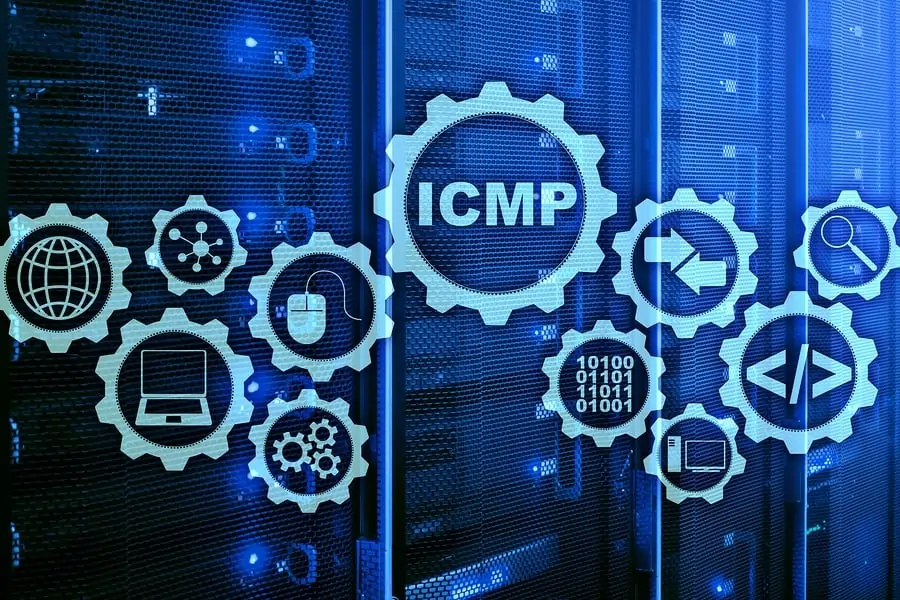Key Takeaways:
- Understand the role of ICMP in network communication and diagnostics.
- Learn how ICMP can help identify and mitigate network issues.
- Explore the security implications and best practices for using ICMP.
What is Internet Control Message Protocol (ICMP)?
ICMP is a cornerstone in network communication, functioning as a crucial network layer protocol for diagnostics and error reporting. Unlike TCP and UDP, it does not carry application data but provides support by transmitting control messages for errors and network operations.
These ICMP messages are encapsulated within IP packets, enabling routers, gateways, and host devices to communicate critical information about network issues. For example, ICMP can inform a sender if a destination is unreachable due to network congestion, excessive latency, or other connectivity problems.
By enabling these real-time notifications, ICMP allows immediate troubleshooting and rapid adjustments to maintain optimal network performance. This utility is essential for the seamless operation of IP networks, as it helps identify faults, ensure efficient data flow, and enhance overall network reliability.
The Role of ICMP in Network Diagnostics
ICMP plays a significant role in network diagnostics by being an essential tool for pinpointing and resolving connectivity issues. When network problems occur, ICMP messages provide alerts about the nature of these issues, enabling quick diagnostics. Ping and traceroute rely heavily on the use of ICMP.
The ping command works by sending ICMP Echo Request messages to a target host and waiting for Echo Reply messages, which help gauge the host’s availability and measure round-trip time. Traceroute, however, tracks the path packets take to reach their destination. It sends packets incrementally, increasing Time-To-Live (TTL) values, eliciting ICMP Time Exceeded messages from intermediate routers, thereby mapping out each hop in the packet’s journey.
This diagnostic capability is invaluable for network administrators as it allows them to quickly identify bottlenecks, locate points of failure, and take corrective actions. ICMP contributes significantly to maintaining network integrity and performance by providing detailed diagnostic information.
Common Types of ICMP Messages
There are several types of ICMP messages, each serving a unique function that aids in maintaining network reliability and efficiency:
- Echo Request and Reply: These messages are integral to the ping command widely used to test device connectivity. An Echo Request is dispatched to the target, which responds with an Echo Reply. This exchange verifies the target’s operational status and provides the round-trip time, indicating the network path’s latency.
- Destination Unreachable: This type of ICMP message indicates that a packet could not reach its intended destination. The causes for failure can range from network congestion to an unavailable host or a blocked port. By providing specific feedback on the causes, Destination Unreachable messages assist network administrators in diagnosing and addressing routing problems efficiently.
- Time Exceeded: These messages are generated when a packet’s Time-To-Live (TTL) value reaches zero, preventing it from circulating indefinitely. Tools like traceroute use these messages to chart the network path of packets by sending them with incrementally increasing TTL values and noting where the packets are discarded.
Security Implications of ICMP
While ICMP is crucial for diagnostics, it can also be a cyberattack vector. Malicious actors often exploit ICMP to conduct various attacks, one of the most notorious being the ICMP flood attack, known colloquially as the Ping of Death. This method consists of overwhelming a target with many ICMP Echo Request packets, which results in the depletion of its resources and leads to unresponsiveness or a crash.
ICMP can also be used for ICMP tunneling, a technique where attackers embed payloads within ICMP packets to stealthily transmit data stealthily, bypassing firewall protections. Another risk associated with ICMP is its use in reconnaissance attacks, allowing attackers to map out network infrastructures and identify vulnerabilities.
Mitigating these risks necessitates stringent ICMP traffic control and monitoring. Network administrators should employ robust filtering rules to limit unnecessary or suspicious ICMP traffic and use intrusion detection systems to detect anomalies. Proactively managing ICMP traffic is essential for maintaining a secure network environment.
Best Practices for Using ICMP
To mitigate the risks associated with ICMP while maximizing its diagnostic benefits, consider these best practices:
- Restrict unnecessary ICMP traffic: Implement firewall rules to limit ICMP traffic strictly to necessary devices and services. It reduces the attack surface and prevents unauthorized or malicious ICMP usage while retaining essential diagnostic functionality.
- Monitor ICMP usage: Continuously analyze ICMP traffic patterns to detect unusual activities that might indicate security threats. Regular monitoring enables the early detection of potential attacks or misconfigurations, facilitating rapid and effective responses.
- Update security settings: Keep firewall and network security settings up to date. Consistently evaluate and adjust ICMP filtering rules to match current security recommendations and threat intelligence, improving the network’s ability to defend against dynamic threats.
Case Study: Companies Using ICMP Effectively
Numerous organizations leverage ICMP to maintain robust network performance and operational efficiency. For example, a leading retail chain used ICMP to swiftly identify and resolve network bottlenecks, significantly enhancing service delivery. By deploying ICMP Echo Request and Echo Reply messages, the company could monitor real-time latency and packet loss, enabling them to optimize their network infrastructure proactively.
Similarly, a technology firm incorporated ICMP into its comprehensive network monitoring strategy to ensure maximal uptime and reliability. The company could proactively identify and address connectivity problems by using tools such as ping and traceroute, reducing the effects on customers and upholding top-notch service levels. These case studies demonstrate the effectiveness of ICMP in supporting robust network management and operational excellence.
Additional Resources and Tools
A wealth of resources is available for those interested in further exploring network diagnostics and security. Check out materials such as the network security tools overview and seek guidance from cybersecurity experts. These resources offer in-depth insights and advanced tools to ensure your network’s security and efficiency.
By delving into these materials, you can comprehensively understand best practices, identify emerging threats, and discover innovative solutions that bolster network resilience and performance. Leveraging these resources will empower you to maintain a secure, efficient, and high-performing network environment.






5 thoughts on “Mastering Network Security: A Guide to Utilizing ICMP for Maximum Protection”